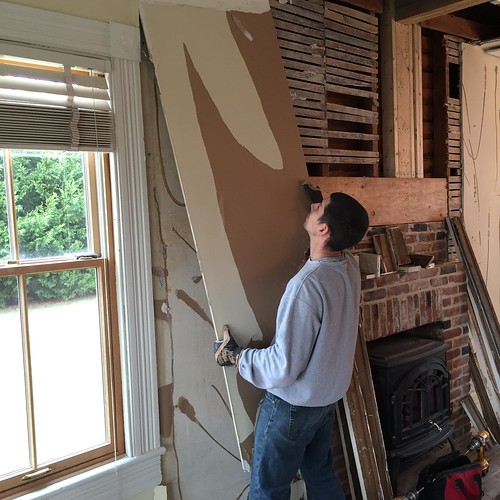We've already reached a point in our new house where our over zealous preservationist ways have begun to impact our projects.
It's no real surprise in a house that's over 100 years old, but by the time we started the removal of the weird partial wall in the living room we already knew we had an issue on our hands. The walls of the room appeared to be in decent shape, appeared to be drywall, but also appeared to hold a secret.
At first glance you probably wouldn't think twice about the walls, assuming someone has simply pulled down the old plaster and put up drywall. Such as life in an old house. It's sad, but it happens more than it should.
But upon closer inspection we noticed something odd. The door and window casings throughout the room seemed to be very thin. These are 100 year old mouldings that should be at least 3/4 if not one inch thick, but we could only see 1/4 to 1/2 inch in front of the drywall.
You could also see the walls seemed to overlap the baseboard cap wherever you could see the original moulding, or a new base cap was put on the old baseboard and it ended up sticking out in front of the profile. It was one of those things that didn't bother me until I really noticed it, but then it was all I could see.
I had a hypothesis that the original plaster walls of the room had been covered over with this layer of drywall, and I wanted so badly to uncover the original fabric of the house and do our best to restore it. The problem, I had no idea what kind of shape it was in. And if it was in bad shape, I might have to end up ripping the whole thing down just to put drywall back up on the lath.
When the wall was removed we could see the original plaster walls and ceiling beneath the layer of drywall on the areas that had been demolished. As much as I also wanted to restore the ceiling, I conceded that we should simply focus on the walls and leave the ceiling drywall intact.
Working with Wendy's Dad, we started to the right of the fireplace to get an idea of what we were dealing with. I started by scoring all of the caulk around any of the moulding areas to ensure I wouldn't end up taking down the window casings too.
Lucky for us (I guess?), it seems the work was done poorly. The first piece of drywall came down rather easy. We ultimately had to more or less break it out piece by piece, but only a handful of 1-1/4" drywall screws were really holding it in place.
These screws were haphazardly placed all over the sheet of drywall and through the plaster, so none of them really held onto anything. There was no care given to ensure the screws has been put into studs, or even lath for that matter.
Instead, it seemed the installed had applied random beads of liquid nails all over the walls in hopes that it would actually hold the drywall in place. In most cases, the irregular dips and peaks of the wall meant the drywall never even touched the liquid nails.
We slowly worked our way around the room removing about 10 four by eight sheets of drywall and exposing the original plaster. In actuality, we were exposing the original wallpaper that had been papered over and painted over several times.
The blue color you see is the scratch coat of the plaster. No top or finish coat was ever applied since they were applying wallpaper. But the wallpaper has begun failing due to water, time, damage, or any other number of issues. But still, you could see the faint wallpaper pattern and some of the flower borders that had been applied over the years.
We even found a bird's nest inside one of the walls. Talk about random and unexpected!
Some drywall came off in small bits and pieces no more than an few inches in size. Other chunks came off in nearly full sheets (but this happened less frequently than we'd hoped).
At the end of the day we were left with plaster walls that were in relatively good shape, tons of wallpaper that has to be removed, a whole lot of liquid nails all over the place, lots of screw holes, a few sections with damage in need of significant repair, and a giant mess to clean up.
Though going this route to renovating the living room in our house is definitely much harder than patching in the holes from the wall removal worn new drywall, it will be well worth it in the end for the charm and character it brings back to the room. We have a long road ahead of us before we're to a point where we can even start applying the finish coat of plaster that was never applied, but it's going to look great when all is said and done. And the best part, all of the original mouldings will once again look like they're supposed to look, rather than flimsy pieces of 1/2" stock barely peeking out from behind the wall.
What do you think? Is the old plaster worth saving and restoring in your book, or are you of the "rip it out and drywall it" mindset? Overall it's in such good shape that we won't even need to use a lot of plaster buttons. We'll need to patch a few holes here and there, and apply some drywall above the doors and fireplace where the plaster was totally removed. We're squarely in the "it looks worse before it looks better" phase, but I'm feeling really good about this project and how it will restore a period look to the room.

![]()
![]()